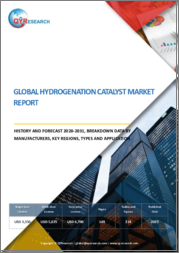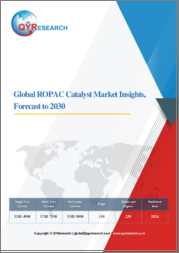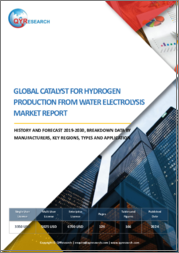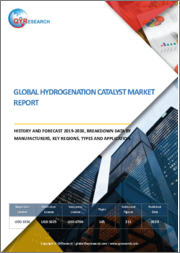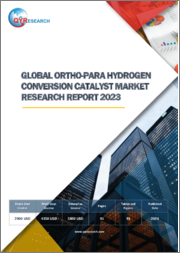
|
시장보고서
상품코드
1804700
수소화 분해 촉매 시장 : 원료 유형, 촉매 유형, 리엑터 기술, 최종사용자 산업별 - 세계 예측(2025-2030년)Hydrotreating Catalysts Market by Feedstock Type, Catalyst Type, Reactor Technology, End-User Industry - Global Forecast 2025-2030 |
||||||
수소화 분해 촉매 시장은 2024년에 13억 9,000만 달러로 평가되었습니다. 2025년에는 14억 6,000만 달러에 이르고, CAGR 5.75%로 성장하여 2030년에는 19억 4,000만 달러에 이를 것으로 예측됩니다.
| 주요 시장 통계 | |
|---|---|
| 기준 연도 : 2024년 | 13억 9,000만 달러 |
| 추정 연도 : 2025년 | 14억 6,000만 달러 |
| 예측 연도 : 2030년 | 19억 4,000만 달러 |
| CAGR(%) | 5.75% |
최신 정유소 운영에서 수소화 분해 촉매의 전략적 중요성, 성능, 규정 준수 및 환경 관리 극대화
석유 정제 산업에서 규제 강화와 원유 목구멍의 변화에 따라 수소화 처리 촉매는 청정 연료 생산 및 공정 신뢰성의 핵심으로 부상하고 있습니다. 촉매 배합의 발전으로 정제업체들은 디젤, 제트 연료, 선박용 연료의 엄격한 저유황 사양을 충족시키면서 더 무겁고 유황 함량이 높은 원료를 처리할 수 있게 되었습니다. 이러한 전략적 요구는 컴플라이언스 준수에 그치지 않고, 전환율 최적화, 온스트림 시간 극대화, 수소 소비량 최소화를 추구하는 정유사의 마진 유지를 뒷받침하는 것입니다.
진화하는 세계 규제 기준과 시장 요구에 부합하는 첨단 수소화 분해 기술로 연료 품질과 배출가스 제어에 혁명을 일으킵니다.
수소화 분해 기술은 촉매 재료, 반응기 구조, 디지털 모니터링 도구의 비약적인 발전에 힘입어 큰 진화를 거듭하고 있습니다. 바이메탈 및 트리메탈릭의 새로운 제법의 등장은 황 제거 효율의 한계를 넓히는 동시에 점점 더 까다로워지는 사용 조건에서 촉매의 수명을 연장하고 있습니다. 한편, 반응기 내부와 분배 시스템의 개선으로 기액 접촉과 열관리가 개선되어 처리 능력 향상과 압력 손실 감소를 실현했습니다.
2025년 미국 관세 조치가 수소화 처리 촉매 조달 및 비용 동향에 미치는 경제적, 경영적 영향 평가
2025년 미국의 수입 수소화 처리 촉매에 대한 관세 개정 일정이 시행됨에 따라 세계 공급망에 새로운 복잡성을 가져왔습니다. 주요 금속 전구체 및 촉매 완제품에 대한 관세가 조정됨에 따라 국내 정련업체들은 즉각적으로 조달 전략을 재검토했습니다. 구매자들이 육지에서의 비용 상승과 특수 촉매 등급의 가용성 사이의 균형을 평가하면서 수입 의존도를 면밀히 조사했습니다.
원료, 촉매, 반응기 기술, 최종 사용자 산업의 통합적 세분화를 통해 시장 역학을 읽고, 전략적 성장 경로를 파악합니다.
시장 세분화에 대한 미묘한 이해는 촉매의 선택을 촉진하는 다양한 용도와 성능 요구 사항을 명확히 합니다. 원료 측면에서 정유소는 나프타 및 스트레이트 랭가스 오일과 같은 경질 중간 원료부터 잔사유 및 진공 가스 오일과 같은 중질 스트림에 이르기까지 각각 고유 한 황 및 질소 프로파일을 가진 다양한 원료를 처리해야 합니다. 마찬가지로, 코발트-몰리브덴 시스템에서 고활성 니켈-텅스텐 시스템까지, 활성 촉매의 선택은 원하는 탈황 강도, 수소화 탈질 요구 사항 및 금속 침전에 의한 비활성화에 대한 내성에 따라 달라집니다.
미주, 중동 및 아프리카, 아시아태평양의 수소화 탈황 촉매 수요 및 채택 동향의 지역적 차이를 살펴봅니다.
수소화 분해 촉매의 채택은 원료의 가용성, 규제 강화, 정제 능력의 확대에 따라 지역별로 뚜렷한 대조를 보이고 있습니다. 북미와 남미에서 정유사들은 풍부한 경질유와 셰일 분획을 활용하고 저유황에서 중질유 흐름에 최적화된 촉매를 선호하는 한편, 북미의 저유황 의무를 준수하기 위해 노후화된 설비를 업그레이드하고 있습니다. 투자 흐름은 개조 프로젝트와 신속한 배치를 목적으로 하는 소규모 모듈 트레인에 집중되어 있습니다.
세계 정제 부문에서 경쟁 우위와 우수한 연구개발을 촉진하는 주요 수소화 분해 촉매 개발 기업 및 기술 혁신 기업 프로파일링
수소화 처리 촉매 공급의 경쟁 환경은 기술 전문가와 종합 정제 파트너에 의해 형성되고 있습니다. 전통 있는 화학업체들은 수십년동안 독자적인 코팅 기술과 함침 기술을 통해 활성 부위의 분산성과 담체의 안정성을 향상시키고, 촉매의 개선을 거듭하며 그 입지를 다져왔습니다. 한편, 소규모 혁신 기업들은 파일럿 규모의 테스트를 가속화하고 바이오 오일이나 재활용 플라스틱과 같은 기존과는 다른 원료에 맞는 제형을 제공함으로써 틈새 시장을 개척하려고 노력하고 있습니다.
수소화 분해 촉매 선택을 최적화하기 위해 정유사 이해관계자들이 얻은 지식을 전략적 이니셔티브와 운영 모범 사례에 반영해야 합니다.
정유사 경영진은 특정 공급 원료의 과제와 처리 능력 목표에 비추어 촉매의 성능을 체계적으로 평가하는 것을 우선시해야 합니다. 공급업체와의 공동 테스트 프로그램에 투자함으로써 실제 운영 조건에서 차세대 재료의 인증을 가속화하여 보다 빠른 배포와 최소한의 시작 리스크를 보장할 수 있습니다. 동시에 장기 공급 계약과 현물 시장 기회의 균형을 맞추는 유연한 조달 전략을 채택하여 갑작스러운 관세 변동이나 원자재 부족을 헤지할 수 있습니다.
엄격한 다중 소스 데이터 수집, 전문가 인터뷰, 분석 프레임워크 채택으로 견고하고 투명한 촉매제 통찰력 확보
본 분석에서는 1차 조사와 2차 조사를 결합한 종합적인 방법을 채택하였습니다. 정제 기술자, 촉매 R&D 전문가 및 업계 컨설턴트와의 전문가 인터뷰를 통해 새로운 성능 동인과 조달 역학에 대한 직접적인 관점을 제공했습니다. 현장 시찰과 파일럿 플랜트 관찰을 통해 반응기 규모의 과제와 촉매 통합 전략에 대한 이해가 깊어졌습니다.
주요 연구 결과를 통합하여 의사결정권자에게 미래 정제 작업을 지원하는 수소화 분해 촉매에 대한 실용적인 인텔리전스를 제공합니다.
이 조사 결과는 수소화 처리 촉매가 전 세계 정유공장의 컴플라이언스 도구이자 마진 개선의 지렛대로서 매우 중요한 역할을 하고 있다는 것을 분명히 보여줍니다. 재료의 혁신으로 황 제거 효율을 높이고 가동 시간을 연장하는 한편, 규제의 강화와 원료의 다양화로 촉매 수요 프로파일은 계속 변화하고 있습니다. 이러한 관세 동향은 공급망 탄력성과 현지 생산 전략의 중요성을 강조하며 정유사들이 조달 및 재고 관리 접근 방식을 재검토하도록 촉구하고 있습니다.
목차
제1장 서문
제2장 조사 방법
제3장 주요 요약
제4장 시장 개요
제5장 시장 역학
제6장 시장 인사이트
- Porter's Five Forces 분석
- PESTEL 분석
제7장 미국 관세의 누적 영향 2025
제8장 수소화 분해 촉매 시장 : 원료 유형별
- 디젤
- 나프타
- 잔류유
- 직류 가스유
- 진공 가스유
제9장 수소화 분해 촉매 시장 : 촉매 유형별
- 코발트 몰리브덴
- 니켈 몰리브덴
- 니켈 텅스텐
제10장 수소화 분해 촉매 시장 : 리엑터 기술별
- 고정 침대
- 이동 침대
- 슬러리 침대
제11장 수소화 분해 촉매 시장 : 최종사용자 산업별
- 바이오연료 가공업체
- 석유화학
- 정유소
제12장 아메리카의 수소화 분해 촉매 시장
- 미국
- 캐나다
- 멕시코
- 브라질
- 아르헨티나
제13장 유럽, 중동 및 아프리카의 수소화 분해 촉매 시장
- 영국
- 독일
- 프랑스
- 러시아
- 이탈리아
- 스페인
- 아랍에미리트(UAE)
- 사우디아라비아
- 남아프리카공화국
- 덴마크
- 네덜란드
- 카타르
- 핀란드
- 스웨덴
- 나이지리아
- 이집트
- 튀르키예
- 이스라엘
- 노르웨이
- 폴란드
- 스위스
제14장 아시아태평양의 수소화 분해 촉매 시장
- 중국
- 인도
- 일본
- 호주
- 한국
- 인도네시아
- 태국
- 필리핀
- 말레이시아
- 싱가포르
- 베트남
- 대만
제15장 경쟁 구도
- 시장 점유율 분석, 2024
- FPNV 포지셔닝 매트릭스, 2024
- 경쟁 분석
- Honeywell International Inc.
- Shell PLC
- Albemarle Corporation
- Arkema group
- Axens
- BASF SE
- Clariant AG
- Evonik Industries AG
- Exxon Mobil Corporation
- HONGKONG SILVER CHEM CO., LTD.
- JGC Catalysts and Chemicals Ltd.
- Johnson Matthey plc
- Kuwait Catalyst Company
- MOGAS Industries, Inc. by Flowserve Corporation
- Nippon Ketjen Co.,Ltd.
- Rezel Catalysts Corporation
- Rosneft Oil Company
- SIE NEFTEHIM, LLC
- Sinopec Catalyst Co., Ltd.
- Sud-Chemie India Pvt. Ltd.
- Topsoe A/S
- W. R. Grace & Co.
- Zeolyst International
제16장 리서치 AI
제17장 리서치 통계
제18장 리서치 컨택트
제19장 리서치 기사
제20장 부록
LSH 25.09.12The Hydrotreating Catalysts Market was valued at USD 1.39 billion in 2024 and is projected to grow to USD 1.46 billion in 2025, with a CAGR of 5.75%, reaching USD 1.94 billion by 2030.
| KEY MARKET STATISTICS | |
|---|---|
| Base Year [2024] | USD 1.39 billion |
| Estimated Year [2025] | USD 1.46 billion |
| Forecast Year [2030] | USD 1.94 billion |
| CAGR (%) | 5.75% |
Unveiling the Strategic Imperative of Hydrotreating Catalysts in Modern Refinery Operations to Maximize Performance, Compliance, and Environmental Stewardship
As the refining industry navigates intensifying regulatory demands and shifting crude slates, hydrotreating catalysts have emerged as a cornerstone of cleaner fuel production and process reliability. Advances in catalyst formulation are enabling refiners to process heavier, more sulfur-laden feedstocks while meeting stringent low-sulfur specifications for diesel, jet fuel, and marine bunkers. This strategic imperative extends beyond compliance; it underpins margin preservation as refiners seek to optimize conversion rates, maximize on-stream time, and minimize hydrogen consumption.
Against this backdrop, refining executives and technology leaders must gain a holistic understanding of catalyst performance metrics, selection criteria, and integration strategies. This executive summary provides a concise synthesis of the critical forces shaping the hydrotreating landscape, setting the stage for deeper exploration of tariff impacts, segmentation nuances, regional adoption patterns, and leading technology providers.
By weaving together technical insights and market intelligence, this report equips decision-makers with the clarity needed to align investment roadmaps with emerging process models. From enhanced reactor designs to tailored catalyst packages, the content ahead is structured to illuminate the pathways through which catalysts can drive both environmental stewardship and economic resilience. With this foundation in place, refining stakeholders can chart a course toward sustained competitive differentiation and operational excellence in a rapidly evolving energy ecosystem.
Revolutionizing Fuel Quality and Emission Control through Advanced Hydrotreating Technologies Aligned with Evolving Global Regulatory Standards and Market Demands
Hydrotreating technology is undergoing a profound evolution fueled by breakthroughs in catalytic materials, reactor architectures, and digital monitoring tools. The rise of novel bimetallic and trimetallic formulations has pushed the boundary of sulfur removal efficiency while extending catalyst lifetimes under increasingly severe service conditions. Meanwhile, enhancements in reactor internals and distribution systems have improved vapor-liquid contact and heat management, unlocking higher throughput and reduced pressure drop.
Regulatory frameworks around the globe are simultaneously tightening, with new mandates for ultra-low sulfur fuel standards driving refiners to invest in more robust hydrotreating trains. In key markets, the transition toward 10 ppm sulfur diesel has accelerated the retirement of legacy units in favor of advanced catalyst beds. At the same time, growing demand for renewable diesel and second-generation biofuels has introduced fresh feedstock challenges, prompting catalyst suppliers to tailor solutions for oxygenated intermediates and varied fatty acid methyl ester inputs.
In parallel, digitalization trends are reshaping catalyst asset management through predictive analytics and condition-based monitoring. Real-time surveillance of pressure differentials, temperature profiles, and hydrogen purity enables proactive turnarounds and yield enhancement. Consequently, the intersection of material innovation, process intensification, and data-driven decision support marks a transformative shift that is redefining both operational benchmarks and capital allocation strategies across the refining sector.
Assessing the Far-Reaching Economic and Operational Implications of the 2025 United States Tariff Measures on Hydrotreating Catalyst Sourcing and Cost Dynamics
In 2025, the implementation of revised tariff schedules on imported hydrotreating catalysts by the United States has introduced a new layer of complexity to global supply chains. The adjusted duties on key metal precursors and finished catalyst products have driven an immediate reassessment of procurement strategies among domestic refiners. Import dependencies have come under scrutiny as buyers evaluate the trade-off between higher landed costs and the availability of specialized catalyst grades.
The tariff measures have also catalyzed a resurgence of regional manufacturing initiatives aimed at reducing exposure to international duty fluctuations. Several catalyst producers have accelerated capacity expansions within North America, including local production of cobalt molybdenum precursors and nickel tungsten active phases. These investments are intended to hedge against future policy shifts and to ensure security of supply for critical refinery operations.
Operationally, refiners are recalibrating inventory policies and negotiating longer-term contracts to mitigate the pricing volatility introduced by tariff revisions. The need for buffer stocks has increased, yet storage constraints and cash-flow considerations have underscored the importance of precise demand forecasting. Ultimately, the 2025 tariff landscape has prompted a delicate balance between cost management, supply chain resilience, and access to cutting-edge catalyst technologies, reshaping partnerships across the value chain.
Decoding Market Dynamics through Integrated Feedstock, Catalyst, Reactor Technology, and End-User Industry Segmentation to Unlock Strategic Growth Pathways
A nuanced understanding of market segmentation reveals the diverse applications and performance requirements driving catalyst selection. On the feedstock front, refineries must address a spectrum spanning light intermediates such as naphtha and straight run gas oil to heavier streams like residual oil and vacuum gas oil, each presenting unique sulfur and nitrogen profiles. Analogously, the choice of active catalyst family-from established cobalt molybdenum compositions to higher-activity nickel tungsten formulations-depends on desired desulfurization intensity, hydrodenitrogenation needs, and resistance to deactivation by metals deposition.
Reactor configuration further influences catalyst performance; fixed beds remain prevalent for their simplicity and proven reliability, while moving bed designs offer continuous catalyst replacement to sustain long-term activity. Slurry bed systems, though less widespread, enable fine control over particle size and more rapid catalyst regeneration cycles. End-users across the spectrum, including specialized biofuel processors, petrochemical operators, and traditional refineries, each impose differing operating pressures, hydrogen consumption targets, and downstream processing constraints.
Taken together, the interplay between feedstock characteristics, catalyst chemistry, reactor engineering, and final product specifications underscores the imperative for tailored catalyst solutions. Only by aligning these variables can refiners achieve optimal sulfur removal, nitrogen reduction, and aromatics saturation without compromising throughput or energy efficiency.
Exploring Regional Variations in Hydrotreating Catalyst Demand and Adoption Trends across the Americas, Europe Middle East & Africa, and Asia-Pacific Zones
Regional adoption of hydrotreating catalysts exhibits marked contrasts driven by feedstock availability, regulatory intensity, and refining capacity expansion. In the Americas, refiners capitalize on abundant light tight oil and shale fractions, favoring catalysts optimized for low to moderate sulfur streams while upgrading aging units to comply with North American low-sulfur mandates. Investment flows are concentrated in retrofit projects and small-scale modular trains designed for rapid deployment.
Across Europe, the Middle East, and Africa, a diverse mixture of domestic crude qualities has necessitated catalysts with broad operational envelopes. Stricter European sulfur standards have spurred demand for high-activity catalyst formulations, even as Middle Eastern operators leverage ultra-low crude sulfur to prioritize throughput. African markets, by contrast, are characterized by a dual emphasis on cost-effective, durable catalysts for low-volume refineries and premium solutions in markets shifting toward cleaner diesel mandates.
In Asia-Pacific, the interplay of rapidly rising fuel consumption, stringent environmental regulations, and a diverse refinery landscape has created demand for flexible catalyst systems. Countries with advanced petrochemical integration are directing catalysts toward meeting both fuel and chemical feedstock specifications, whereas emerging markets emphasize robust, low-cost formulations capable of handling high-sulfur crudes. This regional tapestry underscores the need for suppliers to customize product offerings and service models to local dynamics.
Profiling Leading Hydrotreating Catalyst Developers and Technology Innovators Driving Competitive Advantage and R&D Excellence in the Global Refining Sector
The competitive environment for hydrotreating catalyst supply is shaped by an evolving roster of technology specialists and integrated refining partners. Established chemical producers have fortified their positions through incremental catalyst improvements, leveraging decades of proprietary coating and impregnation techniques to deliver enhanced active site dispersion and support stability. Meanwhile, smaller technology innovators are carving niches by accelerating pilot-scale testing and offering tailored formulations for unconventional feedstocks such as bio-oils and recycled plastics.
Collaborative ventures between catalyst manufacturers and refinery operators are becoming more commonplace, with co-development projects aimed at reducing hydrogen consumption and optimizing process intensification. Strategic alliances extend to joint research agreements with academic institutions, where cutting-edge material science efforts focus on novel supports, dopants, and metal alloys that deliver step changes in performance.
Service offerings have also become a differentiator, with select vendors providing advanced performance monitoring, turnaround planning assistance, and on-site technical support. As a result, contractual models increasingly blend product supply with lifecycle management, fostering deeper partnerships that drive continuous improvement and risk sharing across both routine and complex hydrotreating campaigns.
Translating Insights into Strategic Initiatives and Operational Best Practices for Refinery Stakeholders to Optimize Hydrotreating Catalyst Selection
Refinery executives should prioritize a systematic evaluation of catalyst performance against specific feedstock challenges and throughput objectives. Investing in joint testing programs with suppliers can accelerate the qualification of next-generation materials under actual operating conditions, ensuring faster deployment and minimized start-up risks. In parallel, adopting a flexible procurement strategy that balances long-term supply agreements with spot market opportunities will hedge against sudden tariff shifts or raw material shortages.
Operational best practices include integrating real-time catalyst health indicators-such as delta-pressure trends and sulfur breakthrough curves-into digital control platforms. This enables predictive maintenance planning and extends on-stream time without compromising product quality. Refiners should also explore modular reactor skid designs for rapid catalyst swap-outs, reducing downtime during routine replacements or unexpected deactivations.
Collaboration across the value chain is critical. Engaging in knowledge-sharing forums with technology vendors, engineering contractors, and peer organizations can surface novel process intensification insights. Finally, sustainability goals should be embedded within catalyst selection criteria, favoring formulations that reduce hydrogen consumption and minimize spent catalyst waste through enhanced regeneration protocols.
Employing Rigorous Multi-Source Data Collection, Expert Interviews, and Analytical Frameworks to Ensure Robust and Transparent Catalyst Insights
This analysis draws upon a comprehensive mix of primary and secondary research methodologies. Expert interviews with refining technologists, catalyst R&D specialists, and industry consultants provided firsthand perspectives on emerging performance drivers and procurement dynamics. Site visits and pilot plant observations enriched the understanding of reactor-scale challenges and catalyst integration strategies.
Secondary sources, including technical journals, regulatory bulletins, and patent filings, underpinned the verification of material innovations and process modifications. Catalyst performance data were cross-referenced with publicly available process engineering studies and third-party benchmarking reports to ensure consistency and reliability.
Analytical frameworks applied include scenario mapping of tariff impacts, segmentation matrices for feedstock and reactor typologies, and regional adoption heat maps. Rigorous validation protocols were executed to reconcile conflicting data points and to confirm the credibility of qualitative insights. Collectively, these methods deliver a transparent and replicable foundation for the conclusions and recommendations presented herein.
Synthesizing Key Findings to Empower Decision-Makers with Actionable Intelligence on Hydrotreating Catalysts for Future-Proof Refining Operations
The findings underscore the pivotal role of hydrotreating catalysts as both a compliance tool and a margin-enhancement lever for refiners worldwide. Material innovations are unlocking higher sulfur removal efficiencies and extended run lengths, while regulatory drivers and feedstock diversification continue to reshape catalyst demand profiles. Tariff developments have highlighted the importance of supply chain resilience and localized production strategies, prompting refiners to recalibrate sourcing and inventory management approaches.
Segmentation analysis reveals that catalyst requirements vary significantly across feedstock types, reactor configurations, and end-user objectives, reinforcing the need for bespoke formulations and service models. Regional dynamics further complicate the landscape, as the Americas, EMEA, and Asia-Pacific markets each present unique drivers and constraints that must be addressed through targeted technology and business strategies.
Against this multifaceted backdrop, industry leaders that blend technical collaboration with agile procurement and digital asset management are best positioned to capitalize on emerging opportunities. The actionable recommendations outlined herein offer a roadmap for navigating the complexities of catalyst selection, integration, and performance optimization, enabling decision-makers to future-proof their refining assets.
Table of Contents
1. Preface
- 1.1. Objectives of the Study
- 1.2. Market Segmentation & Coverage
- 1.3. Years Considered for the Study
- 1.4. Currency & Pricing
- 1.5. Language
- 1.6. Stakeholders
2. Research Methodology
- 2.1. Define: Research Objective
- 2.2. Determine: Research Design
- 2.3. Prepare: Research Instrument
- 2.4. Collect: Data Source
- 2.5. Analyze: Data Interpretation
- 2.6. Formulate: Data Verification
- 2.7. Publish: Research Report
- 2.8. Repeat: Report Update
3. Executive Summary
4. Market Overview
- 4.1. Introduction
- 4.2. Market Sizing & Forecasting
5. Market Dynamics
- 5.1. Advancement of nanostructured catalysts boosting sulfur removal efficiency in fuel processing
- 5.2. Integration of green hydrogen sources to develop sustainable hydrotreating catalyst formulations
- 5.3. Exploration of dual function catalysts for simultaneous hydrodesulfurization and hydrodenitrogenation performance enhancement
- 5.4. Tailoring catalyst pore structures to optimize heavy oil hydroprocessing and vacuum residue upgrading reactions
- 5.5. Adoption of machine learning models to predict catalyst deactivation and optimize regeneration cycles in hydrotreating units
- 5.6. Development of metal-organic framework supported catalysts for enhanced stability under severe hydrotreating conditions
- 5.7. Transition toward sulfide-free cobalt molybdenum catalysts for lower environmental footprint and improved process safety
- 5.8. Implementation of continuous petcoke slurry hydrotreating using novel dispersed catalysts under high pressure
6. Market Insights
- 6.1. Porter's Five Forces Analysis
- 6.2. PESTLE Analysis
7. Cumulative Impact of United States Tariffs 2025
8. Hydrotreating Catalysts Market, by Feedstock Type
- 8.1. Introduction
- 8.2. Diesel
- 8.3. Naphtha
- 8.4. Residual Oil
- 8.5. Straight Run Gas Oil
- 8.6. Vacuum Gas Oil
9. Hydrotreating Catalysts Market, by Catalyst Type
- 9.1. Introduction
- 9.2. Cobalt Molybdenum
- 9.3. Nickel Molybdenum
- 9.4. Nickel Tungsten
10. Hydrotreating Catalysts Market, by Reactor Technology
- 10.1. Introduction
- 10.2. Fixed Bed
- 10.3. Moving Bed
- 10.4. Slurry Bed
11. Hydrotreating Catalysts Market, by End-User Industry
- 11.1. Introduction
- 11.2. Biofuel Processors
- 11.3. Petrochemical
- 11.4. Refineries
12. Americas Hydrotreating Catalysts Market
- 12.1. Introduction
- 12.2. United States
- 12.3. Canada
- 12.4. Mexico
- 12.5. Brazil
- 12.6. Argentina
13. Europe, Middle East & Africa Hydrotreating Catalysts Market
- 13.1. Introduction
- 13.2. United Kingdom
- 13.3. Germany
- 13.4. France
- 13.5. Russia
- 13.6. Italy
- 13.7. Spain
- 13.8. United Arab Emirates
- 13.9. Saudi Arabia
- 13.10. South Africa
- 13.11. Denmark
- 13.12. Netherlands
- 13.13. Qatar
- 13.14. Finland
- 13.15. Sweden
- 13.16. Nigeria
- 13.17. Egypt
- 13.18. Turkey
- 13.19. Israel
- 13.20. Norway
- 13.21. Poland
- 13.22. Switzerland
14. Asia-Pacific Hydrotreating Catalysts Market
- 14.1. Introduction
- 14.2. China
- 14.3. India
- 14.4. Japan
- 14.5. Australia
- 14.6. South Korea
- 14.7. Indonesia
- 14.8. Thailand
- 14.9. Philippines
- 14.10. Malaysia
- 14.11. Singapore
- 14.12. Vietnam
- 14.13. Taiwan
15. Competitive Landscape
- 15.1. Market Share Analysis, 2024
- 15.2. FPNV Positioning Matrix, 2024
- 15.3. Competitive Analysis
- 15.3.1. Honeywell International Inc.
- 15.3.2. Shell PLC
- 15.3.3. Albemarle Corporation
- 15.3.4. Arkema group
- 15.3.5. Axens
- 15.3.6. BASF SE
- 15.3.7. Clariant AG
- 15.3.8. Evonik Industries AG
- 15.3.9. Exxon Mobil Corporation
- 15.3.10. HONGKONG SILVER CHEM CO., LTD.
- 15.3.11. JGC Catalysts and Chemicals Ltd.
- 15.3.12. Johnson Matthey plc
- 15.3.13. Kuwait Catalyst Company
- 15.3.14. MOGAS Industries, Inc. by Flowserve Corporation
- 15.3.15. Nippon Ketjen Co.,Ltd.
- 15.3.16. Rezel Catalysts Corporation
- 15.3.17. Rosneft Oil Company
- 15.3.18. SIE NEFTEHIM, LLC
- 15.3.19. Sinopec Catalyst Co., Ltd.
- 15.3.20. Sud-Chemie India Pvt. Ltd.
- 15.3.21. Topsoe A/S
- 15.3.22. W. R. Grace & Co.
- 15.3.23. Zeolyst International






